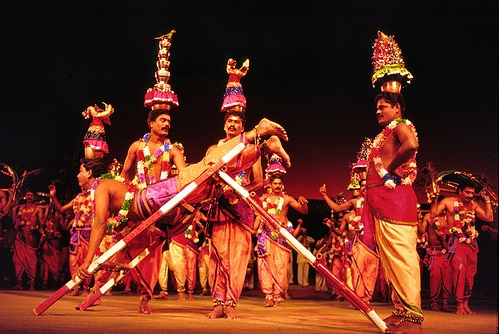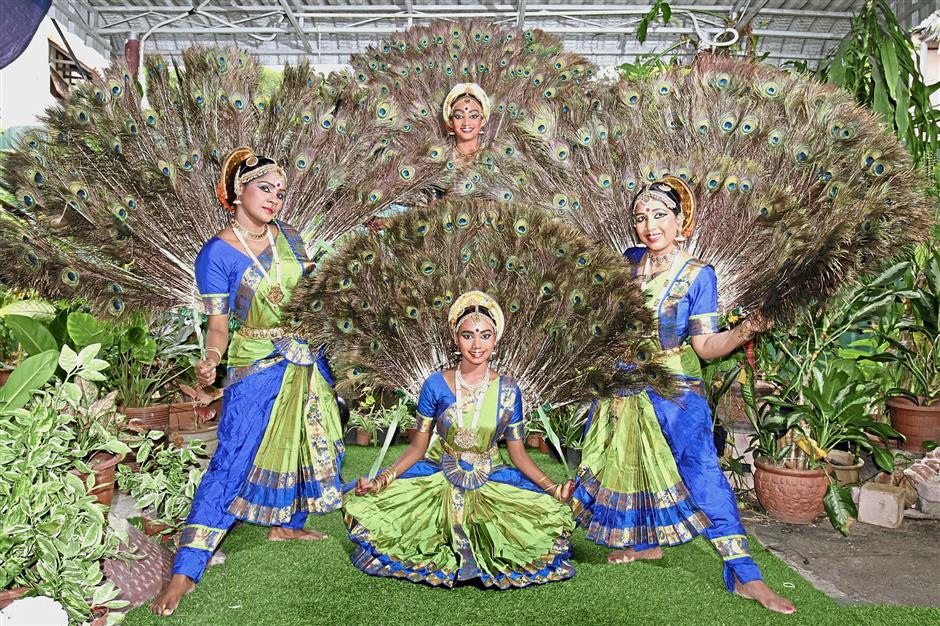Tamilnadu state of India has a large legacy of art and architecture. Besides it the cultural heritage has deep roots in history and civilization of Tamilnadu. The 3 forms of entertainment namely Lyal (Literature), Isai (Music) and Nadagam (drama) play pivotal role. Dance referred as Nadagam in Tamil seeks it is origin from the ancient dance drama known as Therukoothu. The traditions of music and folk dance of Tamilnadu bespeak of the spirit of Tamilnadu and the aesthetic love of the people. Below are the famous Tamil Nadu Dance forms.

The Bharatanatyam is one of the major classical dances of India which finds it is origin from Tamilnadu. This Tamil Nadu dance is performed by ladies showcasing south Indian religious themes. This solo dance is noted for remarkable footwork and sign language based on gestures of hands and ages. Most of the themes of the dance are based on the Hindu legends.
There is a deep spiritual meaning behind bharatanatyam, and it is believed that it is the best form of dance. This ancient form of dance is a living art form that has evolved over the past two centuries. Its beautiful hand and eye movements make it a visual treat, and it is considered the personification of the music. It is a challenging but rewarding discipline that is practiced in many parts of the world.
This dance is a classical form of Indian classical dance that was originally performed in Hindu temples in Tamil Nadu and neighbouring areas. It has a rich history and many exponents. It is considered a form of dance that has universal appeal. In addition, Bharatanatyam has an ancient religious and social value. It is considered a form of worship in India, and it is performed as a way to show respect and honor for the Hindu gods and goddesses.
Rukmini Devi was the first to bring Bharatanatyam to the world’s attention. After her debut performance, she founded the Kalakshetra Institute in Chennai, which promoted the performing arts. Its lineage can be traced to the ancient dance of Sadir Attam. The ancient art form is derived from the Tala (rhythmic pattern) and Bhava (expression). It is also based on the Abhinaya Darpana, which is believed to have been written by Nandikeswara.
Bamber Dance
This Tamil Nadu dance is very popular and is dedicated to the worship of Lord Krishna. This is performed on the eve of Ramanavami inside the temples. It is done around the lamp.
The Bamber dance originated in Tamil Nadu and is a popular form of folk dancing. It is a form of devotional dancing and is performed inside temples on the eve of Ramanavami. It is performed around a lamp and is accompanied by drums, a chair, and a musical instrument. A fire hydrant or Villu is used as an accompaniment during the dance.
The dummy horse is a unique feature of this dance. The dummy horse is made of light-weight material, and the legs are covered with colourful clothes. The performers perform this dance to the rhythm of a long flute and worship the Goddess Amman. The dancers carry colourful cloths on their heads and legs and mimic snake movements with their hands and heads. It is said that this style of dancing was relegated to the villages in the south.
The dummy horse is a special dance form, and involves wearing a dummy horse. The body of the dummy horse is made from light-weight material and colourful clothes are hung on the sides of the animal’s legs. It is a beautiful form of dance, performed with a great deal of artistry and rhythm. The dummy horse is also a popular religious dance in the region, as it is performed to worship the Goddess Amman.
Villu Pattu Dance
Villu Pattu is a notable form of folk dance and attracts the urban and rustic folks alike. In this dance performance the singer is accompanied by a chair and with the musical instrument Villu or view fired with bells. When Villu is struck the jingling of bells starts and the head singer narrates a tale with thrilling songs.
The performance of Villu Pattu is a ritual event with a unique structure. It begins with a curved string, much like a bow, attached to a large earthen jug, which is balanced on a circular plate made of coconut fibre. There are numerous bells attached to the bow’s string, and two cymbals at either end. In the traditional performance, the main performer uses a wooden rod called’veesukkol’ to strike the string in time with the beats. The “possessed” individual then dances spasmodically and intensely, answering questions from the crowd.
Villu Pattu is a traditional art form involving narrating stories to a crowd while striking a bow and resting it on a mud pot. The other performers, whose roles include acting as active listeners and striking the bow during the performance, also perform with a kattai, an instrument similar to a drum. The performance is a highlight for both audiences and performers.
Villu Pattu is performed by a lead storyteller. He often holds a set of notes in front of him and refers to it throughout the performance. Sometimes these notes belong to the local temple, which hires the artist to tell a story about a local deity. In the end, the performance is a raucous spectacle, full of jokes and humour. It is a highly visual and entertaining performance.
Read Related Blogs –
- Scintillating Folk Dance of Karnataka
- Famous Dances of Punjab
- Kerala Folk Dances and Dance Drama
- Know About Nautanki Ramleela and Kathak
Snake Dance
According to the regional rituals of Tamilnadu the snakes have much popularity and their worship is conceived to bless the family and harness the well being of the society. Thus snake dance is one of the popular folk dances of Tamilnadu. In this dance performance the girls perform clad in the attire of snakeskin dress.
In the state of Tamil Nadu, the snake dance, also known as paampu attam, is one of the most famous folk dances. This traditional Tamil dance is performed by girls in snake skin costumes. The dancing is done to worship the serpent god Murugan. The girls in the dance wear tight-fitting costumes resembling those of snakes, and their movements are quite similar to that of a real snake.
This dance originated in the ancient Tamils, who considered snakes as sacred creatures, and worshiped them as a deity. In Hinduism, the serpent is regarded as a protector, and the Snake is worshipped in the southern state to protect the rural people from poison. This unique art form has evolved from a long-established tradition of worshipping the snake, and its performance is an incredibly colorful and entertaining spectacle.
The traditional Snake Dance of Tamil Nadu is also known as Paampu Attam. This is a form of folk art performed by rural women in the southern region. The performers perform this dance wearing snakeskin outfits. It is believed that the dancing of the serpent protects the lives of those who watch it. It is considered as a form of safeguarding the health and prosperity of the people who watch it.
Kolattam Dance
This is a sort of stick dance and emerged as a rustic dance form. The women perform this dance holding two sticks in each of their hands and beat them to make a sound.
The Kolattam dance is an ancient folk art form that originated in Tamil Nadu, India. It is performed as an appeasement dance to the demon Basavasura. It is said to have appeased the vengeful demon and inspired him to stop his evil ways. The tradition of performing the Kolattam dance dates back to the days of the Basavasura legend. Since then, the traditional dance has continued to be performed with the same purpose. It is also thought that this type of folk dance is the personification of Lord Shiva, and that it is worshipped as such.
Kolattam dance is an extremely graceful and beautiful Indian dance. It starts with a chant of the Hindu god, Lord Ganesha. Then, the performers move around the stage in a circle. The music is played by the leaders of the group, who sing the first line of the song, and then the rest of the performers sway to the beat. Many words in the kolattam dance have different meanings. Pennudi means leader of the group, Usi is a change in speed, and Ettugada means beginning of the dance.
The Kolattam dance is a form of Hindu folk dance drama. The leader of the group sings the first line of a song, while the rest of the dancers sway in a circle, moving their bodies in time with the music. The different parts of the dance have different meanings, and the language used in the dance is unique and complex. The words Pennudi means leader of the group, while Usi means a change of speed.
Silambaattam
This had been a popular martial art practiced by the tamil rulers which adopted the form of dance.
Silambam is a weapon-based Indian martial art that originates in Tamil Nadu, South India. It is closely related to the Sri Lankan angampora and the Keralan kalaripayat. The term silambam is derived from the Tamil words silam, which means “hill”, and perambu, which means “bamboo”. The term’silambattam’, or stick fighting, refers to a stick that has a special shape.
The main focus of the art is a bamboo staff. The staff is about one meter in length, but it can be shorter or longer depending on the practitioner. The traditional length of a bamboo staff is 1.68 meters (5 1/2 feet), though different lengths can be used depending on the situation. A three-foot stick is useful as it can be hidden easily. Different staff lengths require separate training and a separate practice.
The staff plays a significant role in silambam. The length depends on the practitioner’s height, but there are several other staff lengths. Some people prefer a three-foot staff as it is easy to conceal. A separate practice is required for different-length staffs. A student who is trained in both styles can learn to use either weapon in single combat. This method is rooted in tradition and is an excellent way to learn the art.
The stick is held in front of the body in a front-facing position. The wrist movement initiates attacks, which are often combined with kaaladi (blows). A silambam fighter’s moves and intentions are never concealed, but they are able to overwhelm their opponent with an unrelenting stream of blows. If they’re able to avoid a lock and counter it with a strike, they’ll be in a much better position to hit their opponent.
Poikkal Kudirai Aattam
This is a dummy horse dance in which the dancer parts the shape of a horse on his hips. This traditional dance of Tamilnadu needs much preparation and skill. The dancing gear is made with utmost care which can swing back and forth coming the legs of the dancer. The dancer has wooden legs to appear like the hooves of the horse. The dancer holds a whip or sword during the performance.
Poikkal Kudirai Aatam is one of the most popular forms of dance in Kerala. It is performed with a lightweight dummy horse wrapped around the waist of the performer. The performance is a regal spectacle, involving heavy facial expressions and continuous beating of a tin drum. The dance is considered a perfect showcase of the art form’s intricate details.
The dance form originated in Thanjavur and was introduced to the state of Tamil Nadu by Marathas in the 2nd century. It is often associated with the goddess Madhavi and is performed to please her village god AYYANAR. The performance is performed as a routine during festivals and is linked to the mystical nature of the Silapathikaram. In addition to the mythological connection, it is a traditional medium in which the hero wears a horse-like structure made of maple leaves.
The form was originally performed by the Goddess Durga. Her enemies used to disguise themselves as scorpions and snakes in order to attack her. To protect herself from the attack, she tied a piece of wood around her legs and danced wildly. The heavy steps of the dance killed the enemies and it was later renamed as Poikkal Kudirai. In modern times, the dance is performed to the music of Naiyandi Melam.
Suggested Tour Packages
- Kerala Tour Packages
- Delhi Tour Packages
- Golden Triangle of Tamilnadu
- South India Tour Packages
- Golden Triangle Tour with Colourful Rajasthan
- Golden Triangle Tour With Lucknow and Bodhgaya
- Golden Triangle Vacations from Kushinagar
- Golden Triangle Tour Packages
- Taj Mahal Tours
- One Day Trip from Delhi
Karakattam Dance 
Karagaattam is a popular folk dance of Tamilnadu which has exception art of the balancing of clay or metal pots on the heads of the dancers. The dance is associated with the worship of Amman. These pots have cone, topped with a paper parrot with the movement of the dancer the parrot birds. The dancers pay respect to Gangai Amman the goddess of river. This unique dance is performed in praise of the rain goddess Mariamman. According to an ancient Tamil epic, Karakaattam evolved from Bharatham, which was a combination of different forms of Tamil dance. This type of music-and-dance performance also incorporates the mudras and postures of Bharatanatyam.
The earliest recorded mention of the art form dates back to five thousand years ago. It is mentioned in an ancient epic that was written in Tamil. It is related to the heritage dance form Bharatham. While there are similarities, this form of music has been accused of being vulgar and erotic. In some recent performances, however, this reputation has been rebutted. It is not a bad thing, and there are even a few interesting sequences in Karakattam.
Karakattam originated in the southern Indian state of Tamil Nadu, and quickly spread to other parts of India. Later, it was brought to Canada by Indian immigrants. The people who perform Karakattam dance are predominantly of the South Asian community. They come from South Asia and Tamil-speaking countries. Some of the top artistes come from Thanjavur and other areas of the Southern part of India. In Canada, karakattam has become very popular.
In the United States, karakattam dancers have been featured in several films, including the film Karagattakaran. This movie became a popular advertisement for the dance form, as it included a karakattam song. Other films with karakattam dancers include the devotional movie Padai Veetu Amman, which featured Meena dancing a traditional festival song. In 2002, the devotional movie Sri Bannari Amman featured a central female devotee as a prayoga.
Chakkai Attam
The word Chekkai signifies special in Tamil and Attam means dance. Chakkai Attam is one of the most popular folk dances of Tamilnadu. In this performance nearly 8 dances gather to form a circle holding wooden pieces with their fingers to produce sound. The songs are sung during the dance to adore the deities.
Kavadi Attam
This dance has tradition has much affinity to North Indian Kaavad Yatras In which people carry Kaavad on their shoulders. Similarly in Tamilnadu the pilgrims carry Kaavad on stick. Just to motogation tiredness they usually sing and dance in the praise of the God. This dance is performed only by the new. In this Balancing of pole is done with pots tied to the stick on either sides of the stick filled with milk or coconut water.
Kummi
In this classical dance form women stand on a circle and clap their hands. Kummi dance is performed on all occasions like religious festivals, family gathering or harvest celebration.
Mayil Attam

This dance is performed by the ladies in Tamilnadu to adore Lord Murugan. In this dance performance women dress like a peacock having peacock Phumbs and sparkling headgears and a beak. This is one of the most popular dances of Tamil folks.
Bommalattam
This refers to puppet show. It is customary to arrange puppet shows in the villages during the time of fairs and festivals of Tamilnadu. The puppets are made of wood, leather and cloth and are operated with the help of strings. The stowes of the puppet shows are taken from the puranas and Indian legends.
Karagam
The village folk dance is performed to appease the rain goddess Mariamman.
Kuravanji
This is a sort of love ballad. This is a mixture of folk and classical dance. This was performed by Devdasi practice is stopped. Kuravanji dance is getting less prevalent.





Pingback: Folk and Classical Tamil Nadu Dance Forms | Book Marking Page
Pingback: Folk and Classical Tamil Nadu Dance Forms - Wiz Article
Pingback: Famous Tourist Fairs & Festivals in India - Taj With Guide Blog
Pingback: Dance Forms of Karnataka - Sam India Tour
zoritoler imol
15 Feb 2023Hello! This is my 1st comment here so I just wanted to give a quick shout out and say I genuinely enjoy reading your posts. Can you suggest any other blogs/websites/forums that deal with the same subjects? Thanks a ton!
zoritoler imol
25 Feb 2023Nice weblog right here! Also your web site loads up fast! What web host are you the use of? Can I get your associate hyperlink in your host? I desire my site loaded up as quickly as yours lol